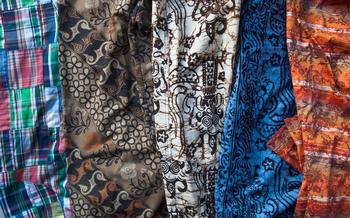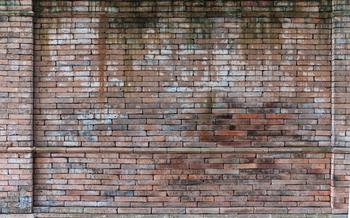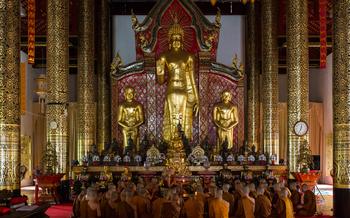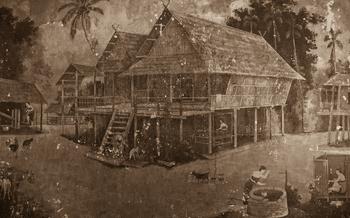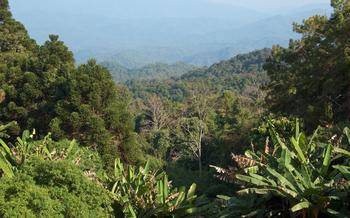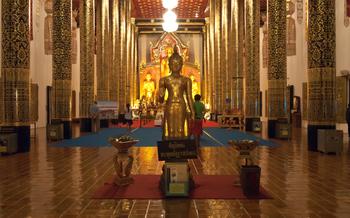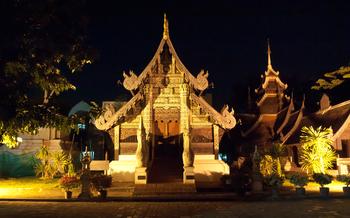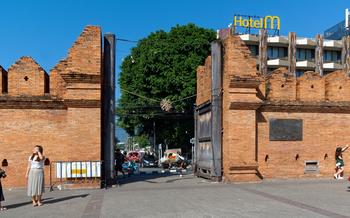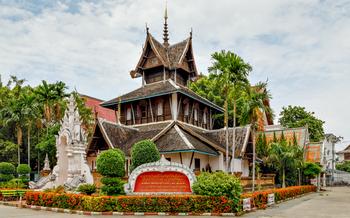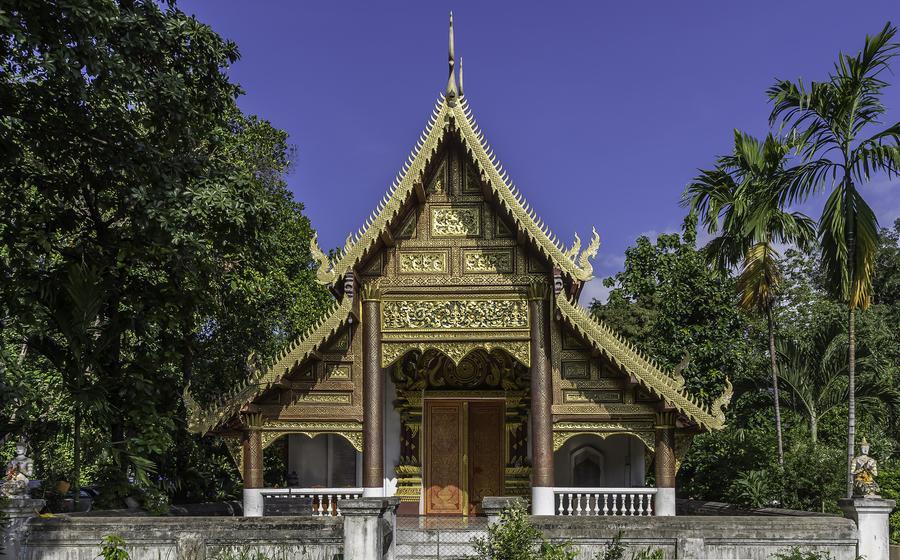
Wat Chiang Man
- Wat Chiang Man: A Historical Gem
- Exploring the Temple Grounds
- Religious Ceremonies and Festivals
- Meditation and Spiritual Retreats
- Community Involvement and Social Projects
- Local Markets and Street Food
- Exploring the Surrounding Area
- Tips for Visitors
- Historical Significance
- Architectural Wonders
- Buddha Images and Relics
- Meditation and Spiritual Practices
- Community Involvement and Social Impact
- Insider Tip: Hidden Gems
Wat Chiang Man: A Historical Gem
Wat Chiang Man, nestled in the heart of Chiang Mai's ancient city, stands as a testament to the city's rich history and profound spiritual significance. Founded in 1296 by King Mengrai, the temple holds the distinction of being the oldest temple in Chiang Mai. Its sacred grounds have witnessed the city's transformation from a modest settlement to a thriving metropolis.
The temple's architecture, a resplendent blend of Lanna and Burmese styles, showcases intricate carvings and exquisite murals that narrate tales from Buddhist mythology. Inside the main prayer hall, visitors are captivated by the awe-inspiring sight of the revered Phra Sila, a 15th-century Buddha image carved from a single block of white marble.
Wat Chiang Man is not merely a place of worship but also a repository of cultural heritage. It houses a collection of ancient artifacts, including centuries-old manuscripts, bronze sculptures, and stupas, each holding a unique story. The temple's significance extends beyond its historical and cultural value; it remains an integral part of Chiang Mai's spiritual identity, drawing countless devotees and visitors seeking solace and enlightenment within its sacred walls.
Exploring the Temple Grounds
The layout of Wat Chiang Man is organized around a central courtyard, with the main prayer hall, or viharn, positioned at the far end. The viharn is a large, rectangular building with a distinctive tiered roof and intricate wood carvings adorning its gables and eaves. Inside, visitors are greeted by a serene and spacious interior, with rows of wooden benches for worshippers and a central altar adorned with Buddha images and offerings.
To the left of the viharn is the chedi, a tall, bell-shaped stupa that serves as a reliquary for sacred objects and a symbol of the Buddha's teachings. The chedi is covered in intricate stucco work and features a series of niches containing Buddha images.
Surrounding the courtyard are several smaller buildings, including a library, a meditation hall, and a museum. The library houses a collection of ancient Buddhist texts and manuscripts, while the meditation hall provides a quiet space for visitors to practice meditation and mindfulness. The museum exhibits a variety of historical artifacts, including ancient Buddha images, pottery, and textiles, offering visitors a glimpse into the rich history and culture of Chiang Mai.
Religious Ceremonies and Festivals
Wat Chiang Man is not just a historical and architectural marvel; it is also a vibrant center of religious activity. Daily rituals and offerings performed by monks create a sacred atmosphere within the temple grounds. Visitors can witness these rituals, which include chanting, meditation, and the offering of alms to the monks.
The temple is also renowned for its colorful festivals and celebrations throughout the year. The most significant of these is the Songkran Festival, the Thai New Year, which takes place in April. During Songkran, the temple becomes a hub of activity, with water splashing, music, and dancing filling the air.
Another important festival is the Loi Krathong Festival, held in November. During this festival, people release floating kratongs, or decorated baskets, into the river to pay respect to the water spirits and bring good luck. Wat Chiang Man is a popular spot for this ritual, as many locals and tourists gather to release their kratongs into the Ping River, which flows nearby.
Participating in these festivals offers a unique opportunity to immerse oneself in Thai culture and traditions and witness the deep devotion and spirituality of the local people.
Meditation and Spiritual Retreats
Amidst the bustling city of Chiang Mai, Wat Chiang Man offers a sanctuary for spiritual seekers and those seeking inner peace. Within the temple grounds, visitors can find a dedicated meditation center where they can learn and practice various meditation techniques under the guidance of experienced monks and teachers.
The meditation center provides a serene and tranquil environment, conducive for deep contemplation and self-reflection. Visitors can choose from a range of meditation programs, from beginner-friendly introductions to advanced retreats for experienced practitioners.
One of the highlights of the meditation center is the mindfulness retreats, which offer a comprehensive immersion into the practice of mindfulness meditation. Through guided sessions, teachings, and group discussions, participants learn to cultivate awareness, presence, and compassion in their daily lives.
The temple also offers opportunities for spiritual guidance and counseling, where visitors can seek advice and support from monks and teachers on their spiritual journey. Whether you're a seasoned meditator or a curious beginner, Wat Chiang Man provides a welcoming and supportive environment for spiritual exploration and growth.
Community Involvement and Social Projects
Wat Chiang Man is not just a place of worship but also an active participant in community development and social welfare initiatives. The temple plays a crucial role in supporting education, providing social welfare services, and undertaking various charitable projects, demonstrating its commitment to the well-being of the local community.
Education:
Wat Chiang Man actively supports education by providing financial assistance to students from disadvantaged backgrounds. The temple also runs a school within its premises, offering quality education to children from the surrounding communities.
Social Welfare:
The temple is deeply involved in social welfare programs, focusing on providing food, shelter, and healthcare to those in need. It operates a soup kitchen that distributes free meals to the poor and homeless. Additionally, the temple provides financial assistance to families facing economic hardship and supports community healthcare initiatives.
Charity Work:
Wat Chiang Man engages in various charitable initiatives to help those in need. It organizes regular fundraising events to collect donations for various causes, such as disaster relief, medical care for the sick, and education for underprivileged children. The temple also works in collaboration with other organizations to provide aid to marginalized communities.
Community Engagement:
The temple actively participates in community events and activities, fostering a sense of togetherness and belonging among the local residents. It organizes cultural festivals, religious ceremonies, and community gatherings, providing opportunities for people to come together, celebrate their shared heritage, and strengthen their bonds.
Local Markets and Street Food
In the vicinity of Wat Chiang Man, a vibrant night market unfolds, inviting visitors to immerse themselves in the bustling atmosphere and culinary delights of Chiang Mai. The air is filled with the tantalizing aromas of local street food, beckoning visitors to indulge in the city's unique flavors.
From crispy grilled meats to fragrant noodle soups, the night market offers a diverse array of culinary creations. Vendors showcase their culinary skills, preparing each dish with care and passion. Visitors can sample the legendary khao soi, a rich and flavorful curry noodle soup, or savor the succulent sai oua, a grilled pork sausage infused with aromatic herbs.
Beyond the savory delights, the night market also presents an array of handmade crafts, souvenirs, and local products. Shoppers can browse through colorful textiles, intricate wood carvings, and unique jewelry, each piece reflecting the artistry and craftsmanship of the local community.
The night market is not merely a place of commerce but also a vibrant social gathering spot. Locals and tourists alike mingle, sharing stories, laughter, and the joy of the communal dining experience. The atmosphere is infectious, drawing visitors into the heart of Chiang Mai's culinary and cultural scene.
Exploring the Surrounding Area
Beyond the temple walls, the area surrounding Wat Chiang Man is a treasure trove of historical sites, cultural attractions, and local experiences. Embark on a leisurely walking tour to discover the hidden gems and immerse yourself in the neighborhood's rich history and vibrant culture.
Stroll through the ancient city of Chiang Mai, with its well-preserved city walls, gates, and moats, transporting you back in time. Visit nearby temples such as Wat Phra Singh, Wat Chedi Luang, and Wat Sri Supan, each with its own unique architectural features and religious significance.
Explore the bustling Chang Klan Road, lined with shops, restaurants, and cafes, offering a glimpse into the modern side of Chiang Mai. Indulge in the delectable street food, sample the local cuisine at charming eateries, and browse the colorful markets for handmade crafts and souvenirs.
Immerse yourself in the local culture by participating in cooking classes, learning traditional dances, or taking a Thai massage course. Visit local farms, markets, and villages to witness the traditional way of life and gain insights into the customs and traditions of the Lanna people.
Whether you prefer exploring historical landmarks, savoring local delicacies, or connecting with the local community, the area around Wat Chiang Man offers a wealth of experiences that will enrich your understanding of Chiang Mai's multifaceted heritage and culture.
Tips for Visitors
When visiting Wat Chiang Man, it is essential to be respectful of the temple's sacred nature and observe proper etiquette. Visitors should dress modestly, with shoulders and knees covered. Shoes must be removed before entering the temple, and it is customary to walk barefoot or in socks.
It is important to be mindful of your behavior and maintain a respectful demeanor within the temple grounds. Loud talking, laughing, or running should be avoided, and visitors should refrain from touching or climbing on the Buddha images or other sacred objects.
Photography is generally allowed at Wat Chiang Man, but it is essential to be respectful and avoid using flash photography, which can be disruptive to the monks and other visitors. It is also important to ask permission before photographing any individuals, especially monks.
Donations are welcome at Wat Chiang Man, and they help support the temple's upkeep and maintenance. Visitors can donate money or offer other items such as food, clothing, or toiletries to the monks.
Historical Significance
Wat Chiang Man holds immense historical significance as the oldest temple in Chiang Mai, dating back to the city's founding in 129It played a pivotal role in establishing Chiang Mai as a significant religious and cultural center in the Lanna Kingdom. The temple's rich history is intertwined with the city's development and has witnessed numerous historical events over the centuries.
Its royal patronage further enhanced the temple's importance, as it was favored by several Lanna kings and rulers. These rulers contributed to the temple's expansion and beautification, adding to its architectural splendor and religious significance. Wat Chiang Man's historical legacy continues to draw visitors from around the world, who come to admire its ancient structures, learn about its fascinating past, and experience its enduring spiritual essence.
The temple's designation as a UNESCO World Heritage Site in 2015 further underscores its global cultural and historical value. This recognition acknowledges Wat Chiang Man's outstanding universal value and its contribution to the rich cultural heritage of Thailand.
Architectural Wonders
Wat Chiang Man showcases the remarkable architectural style known as Lanna, which is distinct to the northern region of Thailand. This style features intricate details, exquisite carvings, and vibrant murals that adorn the temple's structures. Explore the meticulously crafted chedi, with its tiered design symbolizing the different levels of Buddhist enlightenment. Admire the intricately carved wooden doors and windows, adorned with mythical creatures and floral motifs. Discover the symbolic meaning behind each architectural element, such as the viharn, the main prayer hall, which represents the Buddha's teachings and the path to enlightenment. The ongoing preservation efforts at Wat Chiang Man ensure that these architectural wonders continue to captivate visitors for generations to come.
Buddha Images and Relics
Wat Chiang Man is home to a number of revered Buddha images, each with its own unique significance and story. The most famous is the Crystal Buddha, a life-sized statue carved from a single piece of crystal. This stunning image is believed to date back to the 15th century and is considered to be one of the most sacred Buddha images in Thailand.
In addition to the Crystal Buddha, Wat Chiang Man also houses a number of other important Buddha images, including the Phra Sila, a large stone Buddha image that is said to have been created by the Buddha himself; and the Phra Singh, a bronze Buddha image that is believed to have been cast in the 14th century.
The temple is also believed to enshrine a number of Buddha relics, including a hair from the Buddha's head and a bone fragment from his finger. These relics are considered to be extremely sacred and are a major source of pilgrimage for Buddhists from around the world.
Visitors to Wat Chiang Man can pay their respects to the Buddha images and relics by making offerings of flowers, candles, and incense. They can also learn more about the history and significance of these sacred objects by speaking with the temple's monks and guides.
Meditation and Spiritual Practices
Wat Chiang Man is not only a historical and cultural landmark but also a renowned center for meditation and spiritual practices. Visitors seeking inner peace and transformation can immerse themselves in the temple's tranquil atmosphere and engage in various meditation techniques. Experienced monks and teachers offer guidance and instruction on mindfulness and meditation practices, helping visitors to cultivate inner peace, clarity, and self-awareness.
The temple provides a serene and conducive environment for meditation retreats, where participants can delve deeper into their spiritual journey. These retreats typically involve daily meditation sessions, teachings on Buddhist philosophy, and opportunities for self-reflection and introspection. Whether you are a seasoned meditator or a beginner seeking to explore the transformative power of meditation, Wat Chiang Man offers a welcoming and supportive environment for spiritual growth and self-discovery.
Community Involvement and Social Impact
Wat Chiang Man is not just a place of worship and meditation; it also plays a vital role in the local community's social and educational development. The temple is actively involved in various initiatives aimed at improving the lives of the people in Chiang Mai.
One of the temple's primary focuses is education. It runs several programs and initiatives to support the education of children and young adults from the local community. These programs include scholarships, after-school tutoring, and vocational training. The temple also operates a library and a computer lab to provide access to educational resources for the community.
In addition to education, Wat Chiang Man is also involved in various social welfare programs. The temple provides food, shelter, and healthcare to the needy, regardless of their religious or cultural background. It also runs a soup kitchen that serves free meals to the poor and homeless.
The temple's commitment to community development extends beyond its immediate surroundings. Wat Chiang Man has been involved in various projects aimed at improving the infrastructure and quality of life in the region. These projects include building schools, hospitals, and roads, as well as providing clean water and sanitation facilities to rural communities.
Visitors to Wat Chiang Man have the opportunity to contribute to the temple's social initiatives through volunteering. The temple welcomes volunteers from all backgrounds and skill sets, and there are various ways to get involved, such as teaching English, working in the soup kitchen, or helping with community development projects. Volunteering at Wat Chiang Man is a rewarding experience that allows visitors to make a meaningful contribution to the local community while learning about Thai culture and Buddhism.
Insider Tip: Hidden Gems
Beyond the main attractions of Wat Chiang Man, there are hidden gems waiting to be discovered by curious travelers. One such gem is the secret garden, tucked away within the temple grounds. This tranquil oasis offers a serene escape from the bustling city, inviting visitors to pause, reflect, and connect with nature.
Venture to the rooftop of the temple to be rewarded with breathtaking panoramic views of Chiang Mai and the surrounding mountains. The city's vibrant tapestry of colors, the verdant rice fields, and the distant peaks create a picturesque landscape that will leave you in awe.
While at Wat Chiang Man, take the opportunity to learn about the lesser-known local ceremonies and rituals that take place within the temple walls. These intimate glimpses into the local culture provide a deeper understanding of the temple's significance in the community.
Finally, explore the temple's museum to uncover unique and lesser-known artifacts that shed light on the temple's rich history and cultural heritage. From ancient manuscripts to intricate sculptures, each artifact tells a story waiting to be discovered.
